Student enrollment management is a crucial aspect of running any educational institution, particularly a private one.
When successful, this process leads to schools having higher student enrollment and retention rates, increased revenues, and better overall organization and performance.
In this guide, we’ll break down what student enrollment management entails, why it’s important and who is responsible for it, and we’ll follow it up with the key elements of a student enrollment management plan and steps to create it.
- What Is Student Enrollment Management
- Why Is Student Enrollment Management Important
- Who Is Responsible for Student Enrollment Management
- What Should a Student Enrollment Management Plan Include
- How to Create a Student Enrollment Management Plan
- Conclusion
What Is Student Enrollment Management
Student enrollment management is a research-based process aimed at improving student recruitment and retention.
This can be done through marketing strategies, admission policies, retention programs, financial aid schemes, and many other different strategies.
Of course, this process should also include keeping an eye on different enrollment metrics, which can be used to predict enrollment trends and develop suitable adaptation methods.
Considering the significance of enrollment management for educational institutions today, it’s worth revisiting its origin.
And it’s an interesting one, since a single person devised (and successfully implemented) the concept now practiced by most universities, colleges, and schools throughout the U.S. and worldwide.
That person was the Dean of Admissions at Boston College, John Maguire, who in 1976 coined the term “Enrollment Management” in an article published in their alumni magazine.

Source: Hubspot
It should be noted that the title alone succinctly describes the whole point of enrollment management.
In his visionary article, Maguire provides a general definition of enrollment management:
Simply stated, Enrollment Management is a process that brings together often disparate functions having to do with recruiting, funding, tracking, retaining, and replacing students as they move toward, within, and away from the University.
He continues to say that, although most colleges and universities are already using these strategies in one form or another, they should endeavor “to reduce fragmentation by systematizing and integrating these fields into one grand design.”
To give you a better understanding of what a comprehensive student enrollment management plan includes, here’s how Maguire presented it through six enrollment management goals.
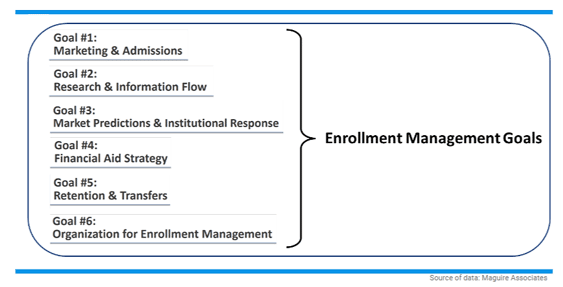
Source: Regpack
Each of these goals is briefly defined. For example, the goal of Marketing & Admissions is:
To develop marketing and admissions programs to attract qualified students in desired numbers.
Goals #2 and #3 are about using student information systems and the latest technologies for research, communications, and planning, as well as developing the capacity to anticipate student interests and devise methods to provide for these interests.
The goal of Financial Aid Strategy deserves another quote:
To implement pricing and financial aid strategies that will optimize the university’s ability to attract and retain the desired academic and socioeconomic mix of students.
This is where it’s made clear that schools should target specific student segments to ensure a diverse and well-rounded student body.
The last two goals are about implementing student retention strategies and organizing departments/roles to facilitate coordination and enrollment management decisions.
Together, these goals represent the framework for creating a strategic, integrative student enrollment management plan, as we’ll see later.
Overall, student enrollment management is an overarching process that aims to integrate different, often uncoordinated, functions tasked with improving student recruitment and retention into a single comprehensive strategy.
Why Is Student Enrollment Management Important
Student enrollment management is critical for the survival of any educational institution as it helps ensure higher student recruitment and retention rates.
This, in turn, increases revenues from tuition payments, fees, and other sources.
Moreover, in today’s world, strategic enrollment management helps schools increase student engagement and satisfaction, enhance communication with prospective and current students, and improve the school’s reputation and market visibility.
Given the current challenges many private educational institutions face, all these benefits make enrollment management even more crucial for their survival in a highly competitive and quickly changing education market.
To illustrate our point, we’ll use higher education institutions as an example.
The first grim fact that many colleges and universities face is the declining student enrollment numbers, indicating that more and more Americans are foregoing higher education, as shown here.
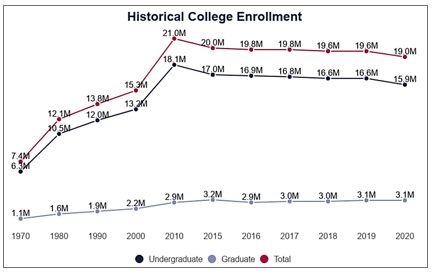
Source: Education Data
In fact, preliminary 2022 data shows that postsecondary enrollment fell by almost 15% compared to 2020.
This decline is caused by many factors, one of which is the availability of other less traditional options to pursue higher education, such as online learning and vocational training.
Other factors include increased competition for a shrinking number of students, rising tuition costs coupled with increased scrutiny of student loan debt issues, and financial difficulties many families are experiencing.
All these factors mean that the livelihood of many higher-education institutions is seriously jeopardized because, as Sean Hill writes in “The History of Enrollment Management”, they are:
too dependent on tuition, for one, as well as auxiliary income (much of which comes traditionally from alumni and endowments), and state support which has plummeted.
Hill proceeds to say that it remains to be seen how these schools will adapt to new circumstances but highlights that their survival is based on how well they can reach out to students and communicate with the public.
All of the above just highlights the importance of student enrollment management.
When properly planned and executed, enrollment management can help schools turn negative trends around by making informed, data-driven decisions to ensure a steady flow of students and revenue and improve their image and market visibility.
Who Is Responsible for Student Enrollment Management
The primary responsibility for student enrollment management usually rests on the shoulders of enrollment directors/managers.
They are tasked with developing and implementing an enrollment management plan and coordinating the efforts of the entire enrollment management team.
The secondary responsibility lies with those members of the school staff responsible for different departments/functions, such as admissions, marketing and recruitment, financial aid, retention, student services, and the like.
So, depending on the institution, its type, size, and organizational setup, an enrollment director can have a range of duties aimed at ensuring that enrollment management efforts are aligned with the school’s overall goals and objectives.
Naturally, with so many factors involved, relevant duties concerned with enrollment management can be performed at various levels and under different titles.
For example, here are just the top responsibilities of Penn State’s Enrollment Services Manager, i.e., enrollment director:
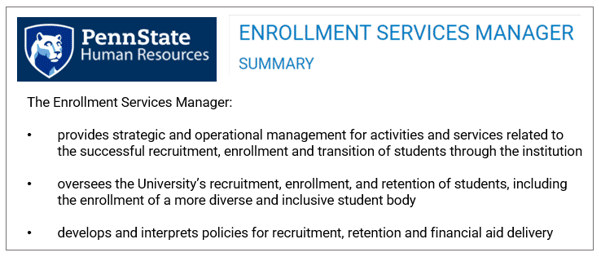
Source: Penn State
With such wide-ranging responsibilities, it’s not surprising that other duties of enrollment directors/managers can include tracking and analyzing enrollment trends, evaluating the enrollment process and identifying areas for improvement, reporting, and budgeting.
Another big part of their leading role is representing their institution at recruitment and financial aid events, board meetings, trustee committees, and presenting information in various public forums.
This means enrollment directors need to be versed in a broad set of management skills, such as leadership, project management, budgeting, financial management, strategic thinking, communication, problem-solving, and interpersonal skills.
We should add that an enrollment director should be familiar with marketing strategies, as well as working with and introducing new technology, as discussed in an article shown below.

Source: Edular
In today’s digital world, there’s no shortage of software tools for managing the entire student enrollment process, analyzing student data and enrollment trends, and generally improving the user experience of students, their families, faculty, and staff.
For instance, an online registration and payment software like Regpack enables the enrollment director and their team members to digitize and automate the entire enrollment process, from online applications to secure payment of fees and tuitions (and donations).
At the same time, it allows the enrollment management team to easily manage and analyze student data and enrollment trends and generate reports.
To sum up, the enrollment director is responsible for creating a student enrollment management plan, overseeing its implementation, and coordinating the efforts of all the functions responsible for the successful recruitment and retention of students.
What Should a Student Enrollment Management Plan Include
Now that we know what student enrollment management is, why it’s important, and who’s responsible for it, it’s time to see what a student enrollment management plan should include.
Let’s first say that such a plan (i.e., the previously mentioned “one grand design”) can also be called an enrollment management strategy, a strategic enrollment plan, or something similar.
Second, one definition of a student enrollment management plan says it is:
a comprehensive process designed to help an institution achieve and maintain optimum recruitment, retention, and graduation rates of students, where ‘optimum’ is defined within the academic context of the institution.
In other words, to formulate an enrollment plan, your school will first need to invest significant time and energy into defining what’s ‘optimum,’ i.e., what it wants to achieve.
Then, you will need to immediately proceed with its implementation while continuously monitoring and adjusting the plan to ensure it stays aligned with the school’s enrollment goals.
Finally, there is no standard format for an enrollment plan, but there are sections that each plan should include, as explained in an article by Enrollment Builders and shown here:
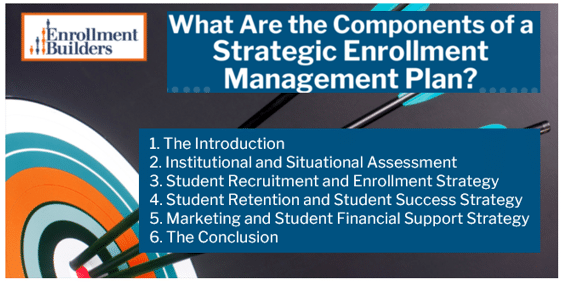
Source: Enrollment Builders
As you can read more about each section in the above-linked article, we’ll focus on the one that requires the most research and analysis but also serves as the basis for all other sections—institutional and situational assessment.
As its name suggests, this assessment should explain the current situation the school is in, including student enrollment trends, as well as demographic, economic, and occupational trends in the school’s target service area.
Moreover, it should compare the described circumstances and trends against the school’s strengths, weaknesses, opportunities, and threats (SWOT), as discussed in the next section.
The institutional and situational assessment should also document the entire enrollment process from a student’s perspective.
Finally, it should list any operational or financial constraints that could prevent the school from reaching its enrollment goals, such as limited campus capacity, and identify its local, regional, or national competitors.
Coupled with the goals, strategies, and tactics defined in its later sections, a student enrollment management plan creates a comprehensive framework for the ongoing process of optimizing the recruitment and retention of students.
How to Create a Student Enrollment Management Plan
Now that we have a general idea of what a student enrollment management plan includes, let’s see how an enrollment director and their team would go about creating it.
Unsurprisingly, the process of creating an enrollment management plan may vary depending on the institution and may include different approaches, stages, and steps, as well as multiple actors, such as faculty, staff across departments, and various consultants.
Despite this complexity, most plans will start with setting enrollment goals and objectives, analyzing enrollment trends, doing market research, and identifying the school’s strengths and weaknesses.
For instance, here’s what steps Enrollment Marketer suggests to take when creating a student enrollment management plan:
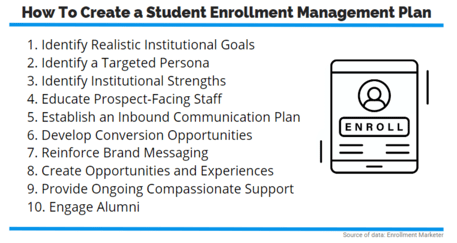
Source: Regpack
We’ll focus on the first three steps as they provide a clear foundation for the entire enrollment management plan and set the direction in which all other steps will go.
So, when identifying enrollment goals, a SMART approach is to make the school’s goals and objectives Specific, Measurable, Attainable, Relevant, and Time-bound.
This widely used formula can help the enrollment director and their team to set realistic and actionable targets.
At the same time, it’s important to think about how these goals and objectives can be measured, i.e., decide which metrics (key performance indicators, KPIs) should be used to track progress toward their realization.
For example, here’s how one community college formulated its overall objective to increase student recruitment efforts in non-traditional settings such as GED preparation classes, career centers, faith-based organizations, and, in this case, homeschooled students.
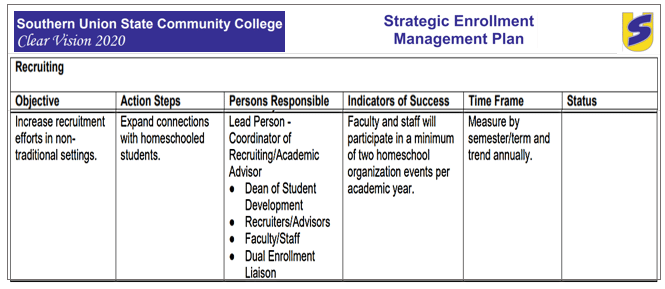
Source: SUSCC
As you can see, the action step is followed by identifying the lead responsible person and other involved stakeholders, the indicators of success (KPIs), and the time frame for measuring that success.
The second step, identifying a targeted persona, refers to market research and student data analysis with the goal of creating hypothetical profiles (personas) of the school’s ideal students.
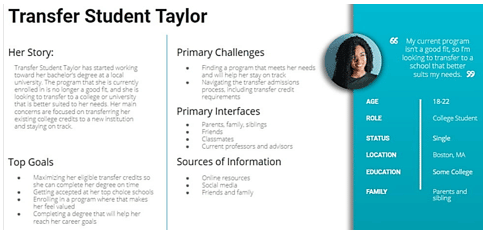
Source: Enrollment Marketer
This can help the school better understand the goals and needs of targeted student segments and focus its enrollment efforts on addressing them, thus attracting the “desired academic and socioeconomic mix of students.”
The third step is evaluating the school’s strengths (selling points) and weaknesses (constraints), marketing opportunities, and competitive threats and then using that knowledge to tailor student enrollment efforts accordingly.
In other words, it’s crucial for the school to understand its market position and determine what sets it apart from its competitors.
That way, the school can align all enrollment management steps, strategies, and policies to effectively communicate its unique selling points to prospective students, their families, and the wider community.
Overall, although creating a student enrollment management plan can be complex, the benefits of implementing it are crucial for your school’s success and long-term survival.
Conclusion
So, we first explained what student enrollment management is, its significance for your school, and who should be responsible for it, to deepen your understanding of this complex subject.
Then, we proceeded to discuss the contents of a student enrollment management plan and the steps to create it.
The main takeaway?
If properly planned and executed, an enrollment management plan can lead to increased enrollment, improved retention, higher student satisfaction, and diversity, all with positive effects on your school’s finances and reputation.


















